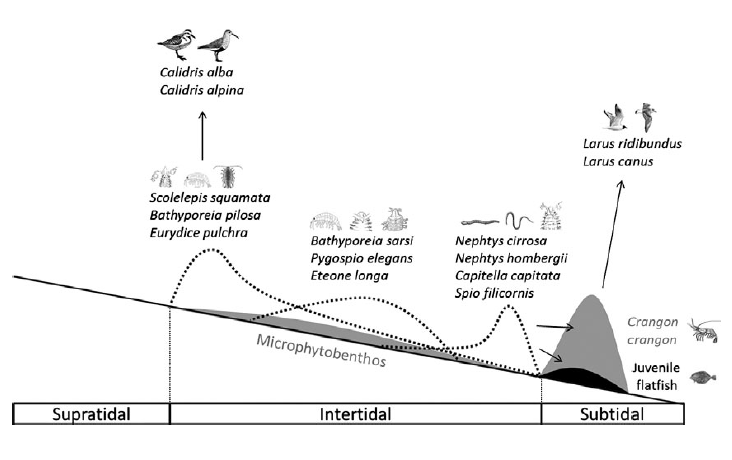Assessing the impact of beach nourishment on the intertidal food web
 Published paper: Assessing the impact of beach nourishment on the intertidal food web through the development of a mechanistic-envelope model
Published paper: Assessing the impact of beach nourishment on the intertidal food web through the development of a mechanistic-envelope model
Beach nourishment, the placement of sand onto a sediment-starved stretch of coast, is widely applied as a soft coastal protection measure because of its reduced ecological impact relative to hard coastal protection. In order to predict effects on the intertidal sandy beach ecosystem, we developed a simulation model that integrates species envelope-based projections for the dominant macrobenthos species and mechanistic food web modules for higher trophic levels.
Species envelopes were estimated by using Bayesian inference of species’ biomass relationships according to the three determining abiotic variables: intertidal elevation, median grain size and total organic matter, obtained from multiple sampling campaigns along the Belgian
coast. Maximum potential abundance of higher trophic levels represented by birds, shrimp and flatfish were estimated based on their derived trophic relationship with macrobenthos.
After validation, we demonstrated that unlike nourishment slope, sediment grain size strongly determines beach-level species richness and production, with strong deterioration in species richness after nourishment with coarse sediment (>300 µm). Patterns for higher trophic
levels do not follow the changes in macrobenthos abundance and biomass.
Synthesis and applications. The optimal grain size range for nourishment of fine-grained beaches is 200–300 µm. This modelling approach shows that the impact assessment of beach nourishment needs to include the evaluation of different species richness and biomass variables.Focusing solely on the potential abundance of species from higher trophic levels might lead to deceptive conclusions due to the dominance of opportunistic prey species.
Figure extracted from the paper: Diagram of the modelled sandy beach food web (density patterns: light grey shaded area: microphytobenthos; dotted lines: macrobenthos; grey shaded area: Crangon crangon; and black shaded area: juvenile flatfish).
Read the paper here.
Authors: Sarah Vanden Eede, Joke Van Tomme, Charlotte De Busschere, Martijn L. Vandegehuchte, Koen Sabbe, Eric W.M. Stienen, Steven Degraer, Magda Vincx and Dries Bonte
